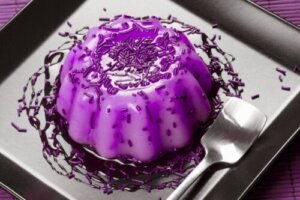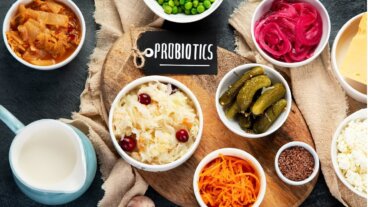Gelling Agents: What Are They and What Are They Used For?


Written and verified by the nutritionist Saúl Sánchez Arias
Gelling agents are artificial additives used to give a better consistency and texture to various foods of industrial origin. They usually increase the viscosity of food products by acting on their structure.
Generally speaking, they’re foods that are usually extracted from natural substances. For this reason, they don’t often have a negative impact on health in the medium term.
Before we begin, it’s important to point out that the best idea is to promote the consumption of fresh foods over industrially processed ones. The former have a higher nutritional density, which is essential to avoid deficits that may condition the correct functioning of our internal organs.
However, it’s fine to include processed foods in the diet on an occasional basis, as long as this doesn’t become a habit.
What are gelling agents?
Normally, gelling agents are stabilizers that cause various mixtures to obtain a texture similar to that of jelly or yogurt. They’re usually introduced in products that have a liquid consistency, although they don’t interfere with the final flavor of the food. They can even be used to suspend particles in a liquid medium, thus combining different textures in the same recipe.

From a chemical point of view, we can explain it by saying that feeling agents are made of carbohydrates or proteins which, when dissolved, form a three-dimensional network capable of trapping solvent molecules. In this way, the viscosity of the food is increased, reaching a solid or semi-solid texture. One of the most typical examples of their use is in jellies and jams.
Another great article: What Types of Food Additives are There?
Most frequently used gelling agents
Among the most frequently used gelling agents, grenetina should be highlighted. It’s obtained from the bones and connective tissue of cattle and is a source of protein. It isn’t bad for increasing the presence of these nutrients in the diet, as they have proven to be essential to prevent the development of pathologies affecting lean mass. However, this isn’t its main function.
Grenetina can be found in the supermarket in sheets or powdered form. In any case, it is necessary to hydrate it in water before introducing it in the different elaborations. These are then heated and subsequently allowed to cool. When their temperature is reduced, the viscosity increases, obtaining a suitable texture.
Grenetina is used to make the more well-known gelling agent gelatin.

Another of the most used gelling agents is agar-agar, which is even more effective than the previously mentioned grenetina. This one has the capacity to gel at room temperature, without the need of refrigeration afterwards. It’s usually soft and brittle but is frequently used in vegan or vegetarian recipes. Its properties are perfectly described in an extensive publication in the journal Carbohydrate Polymers.
You may also be interested in: Food Additives; Allergies, Symptoms, and Treatments
Are gelling agents dangerous?
There’s controversy in scientific research regarding several types of additives due to their possible negative interaction with human physiology. An example would be the case of artificial sweeteners.
There’s evidence to suggest that they have a negative impact on the density and diversity of the microbiota, thus favoring subsequent digestive processes. However, this isn’t the case with gelling agents.
Most of them are considered to be very safe compounds for health and can be included in the diet on a regular basis without major problems. In fact, there are many recipes to prepare at home that include these compounds among their ingredients. It’s easy to find them in almost any supermarket. Their culinary application is simple and doesn’t require expensive techniques to achieve excellent results.
However, this doesn’t mean that, in general, it’s better to prioritize the consumption of fresh foods rather than processed foods with gelling agents inside. This isn’t because of the presence of these additives as such, but simply because these foodstuffs usually also contain other compounds of lower quality, such as simple sugars and trans fats. In addition, the nutritional density is lower than that of fresh foods.
Gelling agents are additives that improve texture
As you have seen, gelling agents are additives that are used in the context of industry or home recipes to improve the texture and organoleptic characteristics of certain recipes.
They don’t provoke negative effects on health and can be included in the diet on a regular basis without major inconveniences. Most of them are proteins or carbohydrates that form three-dimensional networks from the chemical point of view.
Finally, we need to mention that if you find that gelling agents cause digestive problems, then you’ll need to check this out with your doctor. If there’s any internal inflammation, then it may be the case that these elements are causing a certain reaction. In this case, it’ll be necessary to start specific treatment aimed at efficiently controlling the symptomatology.
All cited sources were thoroughly reviewed by our team to ensure their quality, reliability, currency, and validity. The bibliography of this article was considered reliable and of academic or scientific accuracy.
- Prokopidis, K., Cervo, M. M., Gandham, A., & Scott, D. (2020). Impact of Protein Intake in Older Adults with Sarcopenia and Obesity: A Gut Microbiota Perspective. Nutrients, 12(8), 2285. https://doi.org/10.3390/nu12082285
- Chen, X., Fu, X., Huang, L., Xu, J., & Gao, X. (2021). Agar oligosaccharides: A review of preparation, structures, bioactivities and application. Carbohydrate polymers, 265, 118076. https://doi.org/10.1016/j.carbpol.2021.118076
- Suez, J., Korem, T., Zeevi, D., Zilberman-Schapira, G., Thaiss, C. A., Maza, O., Israeli, D., Zmora, N., Gilad, S., Weinberger, A., Kuperman, Y., Harmelin, A., Kolodkin-Gal, I., Shapiro, H., Halpern, Z., Segal, E., & Elinav, E. (2014). Artificial sweeteners induce glucose intolerance by altering the gut microbiota. Nature, 514(7521), 181–186. https://doi.org/10.1038/nature13793
This text is provided for informational purposes only and does not replace consultation with a professional. If in doubt, consult your specialist.








